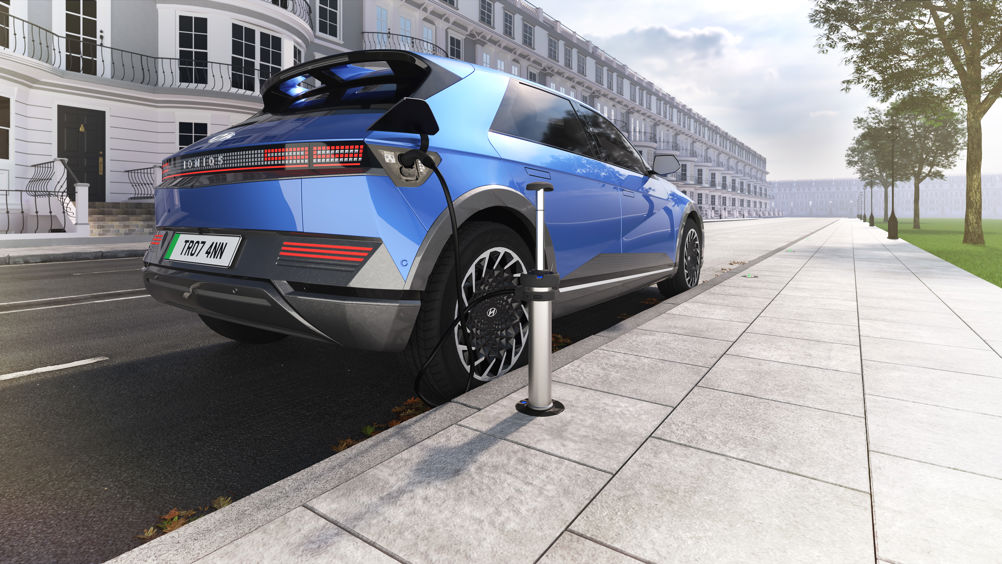Under current plans, the UK is set to ban the sale of new petrol and diesel cars by 2030. At that point, the government wants a minimum of 300,000 public chargers installed, supporting what it hopes will be a smooth transition to electric vehicles (EVs), where everyone can charge at will, with a minimum of inconvenience.
The latest figures from ZapMap – a digital database/app that tracks UK charging infrastructure - show that there are now around 37,000 public charge points, housing roughly 61,000 total connections. The experience of using these public chargers can differ wildly, depending on your circumstances. For those with driveways who can charge at home, public charging is often just a top-up on a long journey, a chance to stretch the legs while ‘ultra-rapid’ chargers add dozens of miles of range in minutes, often at bespoke motorway facilities designed precisely for this purpose. For the almost two-thirds of the UK population without a driveway, the charging experience can be more of a challenge.
“The only reason I do it is because I do this job and I therefore need to have an EV and I’m a proper early adopter, so I believe in this in my core,” Chris Pateman-Jones, CEO at Connected Kerb, told The Engineer. Despite heading up an EV infrastructure company at the vanguard of UK charge point rollout, Pateman-Jones is not shy about critiquing the current state of play. With no driveway, he relies on rapid charge points more than a kilometre away, scheduling recharges when required. On arrival, he often has to wait for a charging bay or call tech support to get a device rebooted.
“It is a catastrophically bad experience for me,” he said. “Rapids at the moment basically make lives marginally bearable for people who adopt EVs who don’t have a driveway...but it’s not a convenient experience.”

Much is made of the charging speeds at which rapids and ultra-rapids can now reach. The latest and greatest chargers offered by GRIDSERVE (see p 22), for example, at its high-tech Electric Forecourts, can deliver 360kW – enough to add 100 miles of range in under five minutes. This kind of power makes for good headlines. However, it is on the residential streets of the UK where the real battle for electrification will be fought.
“I think you need to have a truly blended infrastructure network,” said Pateman-Jones. “(Rapids) are particularly important right now because they give people confidence about switching. But we know from our own data that when you then put the on-street stuff close to them or you put in workplace charging, the use of rapids goes down.”
Charging at 360kW will minimise your wait time at a motorway forecourt, but what’s really needed to turbocharge the EV transition is, ironically, slow and steady on-street charging, used primarily by local residents to charge overnight when grid demand is low.
“When you’re charging at home you have three things: convenience, affordability and reliability,” said Pateman-Jones. “Affordability is very important when you’re on a motorway and affordability is a higher priority because you could drive on to the next service station if you’re not happy. In a local residential on-street area it’s much less important because you’re talking much lower prices to charge, so a couple of pence doesn’t make such a big difference...but convenience becomes much, much more important. And the situation at the moment - if you don’t have a drive - is basically convenience goes out the window.”
The ‘300k by 2030’ target presupposes a heavy reliance on rapids and ultra-rapids. If, as Pateman-Jones believes, on-street overnight charging becomes the dominant preference, the number required is likely to be closer to 700k, a figure that would demand northwards of 200 charge points per day to be rolled out between now and 2030. It’s a daunting task – one that grows tougher each day we miss that quota - as well as a major engineering and logistical challenge. According to Pateman-Jones, we’re a long way off the pace.

“On a really good month, we’re doing 500,” he said. “There’s no one else getting anywhere near that at the moment...so the point I’m making is we’re nowhere near hitting that 2030 target that the government set out.
“But the important part is to get to the 2050 point where the likes of
(US business consultants) Frost & Sullivan and others are talking about 2.9 million public charging points being required. So we’re really just scratching the itch at the moment.”
Those sorts of figures will require a fundamental transformation of the UK’s cities and suburbs over the coming decades, with on-street charging available virtually everywhere. Destination, workplace and motorway charging can pick up some of the slack, but the heavy lifting will have to be done overnight by a network of ‘fast’ rather than ‘rapid’ chargers, drawing from the grid while the nation sleeps.
“The message from anyone who’s saying it’s just about rapids is basically ‘your time isn’t important to us and you need to prioritise driving down the road to go and charge your car’,” said Pateman-Jones. “And if that is the message, I can basically say, categorically, I don’t think you’ll get full transition to EV.”

There is an intriguing psychological component to the charging rollout, trying to predict how the Great British Public will react and adapt to this changing automotive landscape. Despite the advances in high-speed charging, cost-effectively refuelling EVs takes hours rather than minutes. Those without driveways may have to reluctantly leave vehicles overnight on out-of-sight streets, minutes rather than seconds from their front doors. But with cars so intimately linked with our psyche - a statement of identity as well as status - challenges to norms around driving and parking will undoubtedly face some resistance.
“Consumers don’t know how they’re going to behave, I don’t think, until they’ve got an electric car and actually test it out for themselves. There’s a difference between perception and reality,” said Lauren Pamma, programme director at the Coalition for the Decarbonisation of Transport (CDRT).
As part of the government-backed Green Finance Initiative, the CDRT aims to unlock financial solutions to net zero challenges. According to Pamma, barriers to investment in EV charging include a general lack of knowledge and understanding of the sector and the different business models at play. For a charge point to be financially viable, it needs to have a certain utilisation rate, generating enough profit to justify installation and upkeep. But gauging utilisation levels of chargers in these early days of electrification is a tricky business. Several experts I spoke to referenced the chicken and egg conundrum of EV infrastructure and ownership: people are hesitant to buy EVs without charge points, but installing the infrastructure doesn’t make economic sense unless people have EVs to use it.
One method the CDRT is exploring to overcome this is ‘utilisation-linked loans’, whereby the rate of payback is dictated by how much revenue charge points are actually generating. Similar in some ways to student loans, this model could see the government having a role to play in subsidising the investment by reducing risk, according to Pamma.
“Could they provide some sort of backstop that derisks that investment for private sector?” she said. “It’s something that we are looking at implementing and trying to get a pilot off the ground.”
Different modes of charging will also require different finance models. Service station-style ultra-rapid charging requires big upfront spend but should generate solid revenue from day one, both from charging and co-located shops and facilities. On-street rollout may demand less capital initially but most likely comes with a payback over a longer duration of perhaps 10-15 years.
“There isn’t one winning business model. There’s going to be a mix of successful business models, each with different risk and return profiles,” said Pamma.
For short-term gain, charge-point operators might be tempted to deploy exclusively across the likes of Chelsea and Kensington, where car ownership is high and many have the means to purchase EVs today. But over the next 20 years, areas on the outskirts of cities should have higher utilisation rates. Weaker public transport and less home-working means the need to drive is generally greater, leading to more miles clocked up per vehicle and financial rewards for operators willing to play the long game. This also requires councils to think bigger picture, according to Pateman-Jones.
“We need to get to long-term contracts so you can make your money back over a longer period of time,” he said. “We obviously would say that because we’ve built our kit to last 15 to 25 years.
“We deploy kit that lasts two or three times longer than anyone else’s on the market. And we do that because we think you can only make this work for the user if you have something that has a low total lifecycle cost, you can’t do that if you’re replacing something every five to seven years, you have to build something that is long life.”
The durability of Connected Kerb’s charging hardware has helped make it one of the fastest-growing players in the sector. In fact, according to Pateman-Jones, the company is currently winning too much business, something you won’t often hear uttered by a CEO.
“The reason, to be very clear, that we win, is because our kit is the best in the market and our network operates better than anyone else’s in the market,” he said, returning to more familiar CEO territory. “We have a win rate that’s...between 60 and 70 per cent. As much as I’m delighted by that, it’s not necessarily a sign of a good market....so I would like the rest of the market to step up to that.”
One of the newer entrants to the market looking to do just that is Trojan Energy. Founded in Aberdeen by former oil and gas engineers aiming to pivot towards a greener future, Trojan’s USP is its flat-and-flush on-street system that embeds discrete charge points in the pavement near the kerb, with drivers using a specially designed ‘lance’ that slots into these points and then connects to the vehicle.

A handle at the top of the lance - designed in consultation with Disability Rights UK - makes it easier to detect for pedestrians, particularly those with visual impairment and wheelchair users. When not in use, the infrastructure is designed to be as unobtrusive as possible, with street furniture that is virtually invisible. But blending into the environment in this way also means it must be able to withstand the daily grind of life on the mean streets.
“One of the things we realised, because it’s a flat-and-flush point on the street, it’s going to be run over by not just cars but by HGVs,” said Hugh Mackenzie, chief operations officer at Trojan Energy. “So it’s essentially got to have the same rating as a manhole cover.”
As for the lance, its visibility makes it a potential target for vandalism, which had to be incorporated into the design from the start.
“We tested what we thought might be the worst case of vandalism loads, and a baseball bat seemed like a pretty aggressive one to us. And it stood up remarkably well,” said Cameron Baker, engineering design principal at PDD, who worked with Trojan developing the system. “You could still pull the lance out, albeit dented.”
The Camden trial has so far been a big success, with 100 drivers on a waiting list for charging lances. Trojan is also in negotiations for a long-term contract with the borough that could potentially see the expansion of the scheme, subject to consultation with Camden residents and the pedestrians that will have to share the pavements with the charging infrastructure. According to MacKenzie, Trojan is currently rolling out a 500-unit project in Barnet, set to complete in March 2023. “That’s the scale we need to go to,” he said.

Connected Kerb is already rolling out on-street at this scale and beyond. The company has a contract for 7,000 points across West Sussex, which is the sort of ambition Pateman-Jones wants to see across the whole country.
“There needs to be an acceleration of procurement,” he said. “Really, every county in the UK needs to be tendering, and we suspect that they will within the next sort of five to six years.”
This mass rollout by councils around the country will inevitably ruffle a few feathers, as residential streets are dug up. According to Shira Lapin, innovation project lead at UK Power Networks, planning and coordination between the various stakeholders is vital for ‘digging once’ and minimising disruption.
“It’s necessary for progress, but you want to do it as quickly and as painlessly as possible,” she said. The scale of the task also presents an enormous skills challenge, both in traditional roles and some less expected ones.
“First of all, you do need engineers on the ground, delivering the reinforcement, delivering the civils, wiring in the charge points, all of that,” said Lappin. “You need apprenticeships to upskill network engineers and engineers for the charge point operators, but then you also need to plan where those 300k charge points go so that they’re in the right place...so there’s a lot of digital skills around analysing data and forecasts and patterns to see where charge points go.”
Ensuring there is an equitable charging infrastructure for all is also a key focus for Connected Kerb. The company has invested significant resources into developing an AI platform that crunches huge amounts of data to inform its rollout decisions.
“It ingests I think now over 40 different datasets and we built the tool to be able to ingest more, so when we work with local councils they can then give us additional datasets that we might not have access to publicly,” said Pateman-Jones.
“We’re able to blend the human data alongside the physical data. It means we can do line searches in there in terms of power availability. We can look at parking spaces. We can look at trees in the local area, existing street furniture, relative proportions of off-street versus on-street parking. All of these sorts of things together with wealth profile, industry, commuting distances. Together those things basically help us to identify areas and streets which make sense.”
Computers may be able to tell us where the chargers should go, but that’s the easy bit. Even the low-end figure of 300k public devices by 2030 seems a long way off, a massive engineering and logistical challenge. Roll on the rollout.












McMurtry Spéirling defies gravity using fan downforce
Ground effect fans were banned from competitive motorsport from the end of the 1978 season following the introduction of Gordon Murray's Brabham...